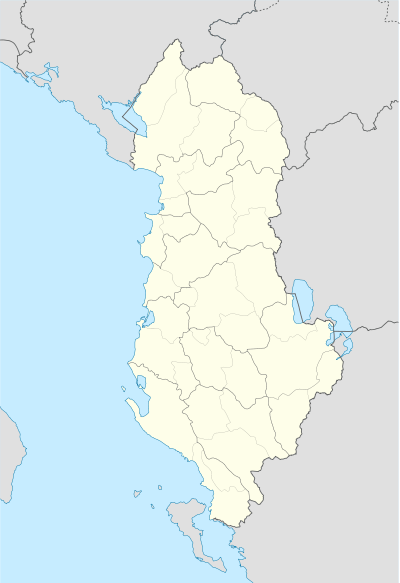Piqeras
| Piqeras | |
|---|---|
| Village | |
 Piqeras | |
| Coordinates: 40°0′59″N 19°53′33″E / 40.01639°N 19.89250°ECoordinates: 40°0′59″N 19°53′33″E / 40.01639°N 19.89250°E | |
| Country |
|
| County | Vlorë |
| Municipality | Himarë |
| Administrative Unit | Lukovë |
| Time zone | CET (UTC+1) |
| • Summer (DST) | CEST (UTC+2) |
Piqeras (Greek: Πικέρνη Pikerni) is a village in the former municipality of Lukovë, Vlorë County, southern Albania. At the 2015 local government reform it became part of the municipality Himarë.[1]
Demographics
In fieldwork conducted in 1992, Piqeras had a total population of 991 and inhabited by an Orthodox Albanian majority with a minority of 100 Muslim Albanians and 50 Greeks.[2]
History
During the Ottoman period (15th-1912) the village enjoyed a special administrative status as part of the Himara region.[3] In 1742 the neighbouring Muslim Albanian village of Borsh attacked Piqeras making some Albanian speaking Orthodox Christians flee abroad to southern Italy were they founded the village of Villa Badessa.[4] In 1875, some families with Piqeras heritage from Villa Badessa decided to relocate to Nea Pikerni, a settlement founded by the Greek state in the Peloponnese which after some time was abandoned due to economic and relocation hardships.[4]
A Greek school was operating in Piqeras from 1871. Greek education was sponsored by the local diaspora and in 1902-1904 it was expanded with a girls' and a middle level school.[5] In 1914 local armed groups supported the struggle for the establishment of the Autonomous Republic of Northern Epirus and participated in fierce fighting for the control of the nearby Fterrë village and the heights around Çorraj village.[6]
The village is the birthplace of the Albanian national hero Vasil Laçi who attempted to assassinate Victor Emmanuel III, King of Italy and Shefqet Bej Vërlaci, Prime Minister of Albania after the occupation of Albania by fascist Italy.[7]
References
- ↑ Law nr. 115/2014
- ↑ Kallivretakis, Leonidas (1995). "Η ελληνική κοινότητα της Αλβανίας υπό το πρίσμα της ιστορικής γεωγραφίας και δημογραφίας [The Greek Community of Albania in terms of historical geography and demography." In Nikolakopoulos, Ilias, Kouloubis Theodoros A. & Thanos M. Veremis (eds). Ο Ελληνισμός της Αλβανίας [The Greeks of Albania]. University of Athens. p. 34. "Στα πλαίσια της επιτόπιας έρευνας που πραγματοποιήσαμε στην Αλβανία (Νοέμβριος-Δεκέμβριος 1992), μελετήσαμε το ζήτημα των εθνοπολιτισμικών ομάδων, όπως αυτές συνειδητοποιούνται σήμερα επί τόπου. [As part of the fieldwork we held in Albania (November–December 1992), we studied the issue of ethnocultural groups, as they are realized today on the spot.]"; p. 51. "Ε Έλληνες, ΑΧ Αλβανοί Ορθόδοξοι Χριστιανοί, AM Αλβανοί Μουσουλμάνοι"; p. 53. "PIQERAS ΠΙΚΙΕΡΑΣ (ΠΙΚΕΡΝΗ) 991 ΑΧ + αμ (100) + ε (50)".
- ↑ Sakellariou, M.V. (1997). Epirus, 4000 years of Greek History and Civilization. Athēna: Ekdotike Athenon. p. 255. ISBN 9789602133712.
In Cheimara and the villages of its region (Nivitsa, Hagios Basileios, Loukovo, Keparon, Drymades, Vounos, Pikerni), the court consisted exclusively of elders...
- 1 2 Kallivretakis, Leonidas (2003). "Νέα Πικέρνη Δήμου Βουπρασίων: το χρονικό ενός οικισμού της Πελοποννήσου τον 19ο αιώνα (και η περιπέτεια ενός πληθυσμού) [Nea Pikerni of Demos Vouprassion: The chronicle of a 19th century Peloponnesian settlement (and the adventures of a population)]". In Panagiotopoulos, Vasilis, et al (eds). Πληθυσμοί και οικισμοί του ελληνικού χώρου: ιστορικά μελετήματα [Populations and settlements of the Greek villages: historical essays]. Institute for Neohellenic Research. pp. 233-240.
- ↑ Koltsida, Athina. Η Εκπαίδευση στη Βόρεια Ήπειρο κατά την Ύστερη Περίοδο της Οθωμανικής Αυτοκρατορίας (PDF) (in Greek). University of Thessaloniki. pp. 187, 277. Retrieved 2 December 2012.
- ↑ ...], Hellenic Army General Staff, Army History Directorate. [Ed. comm.: Dimitrios Gedeon (2000). The struggle for Northern Epirus (1.udg. ed.). Athens: Hellenic Army General Staff, Army History Directorate. p. 260. ISBN 9789607897404.
On 11 June the armed bands from the villages of Pikerasi and Keparo, together with the 1st Company of the Karasevdas Battalion, continued to advance northwards... After fierce fighting the Autonomists were able to hold the line from the south heights of Chorraj to Ftera
- ↑ Owen Pearson (11 July 2006). Albania in the Twentieth Century, A History: Volume II: Albania in Occupation and War, 1939-45. I.B.Tauris. pp. 153–. ISBN 978-1-84511-104-5.
